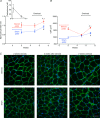A cellular memory mechanism aids overload hypertrophy in muscle long after an episodic exposure to anabolic steroids
- PMID: 24167222
- PMCID: PMC3892473
- DOI: 10.1113/jphysiol.2013.264457
A cellular memory mechanism aids overload hypertrophy in muscle long after an episodic exposure to anabolic steroids
Abstract
Previous strength training with or without the use of anabolic steroids facilitates subsequent re-acquisition of muscle mass even after long intervening periods of inactivity. Based on in vivo and ex vivo microscopy we here propose a cellular memory mechanism residing in the muscle cells. Female mice were treated with testosterone propionate for 14 days, inducing a 66% increase in the number of myonuclei and a 77% increase in fibre cross-sectional area. Three weeks after removing the drug, fibre size was decreased to the same level as in sham treated animals, but the number of nuclei remained elevated for at least 3 months (>10% of the mouse lifespan). At this time, when the myonuclei-rich muscles were exposed to overload-exercise for 6 days, the fibre cross-sectional area increased by 31% while control muscles did not grow significantly. We suggest that the lasting, elevated number of myonuclei constitutes a cellular memory facilitating subsequent muscle overload hypertrophy. Our findings might have consequences for the exclusion time of doping offenders. Since the ability to generate new myonuclei is impaired in the elderly our data also invites speculation that it might be beneficial to perform strength training when young in order to benefit in senescence.
Figures




Comment in
-
Muscle nuclei remember to cheat death.J Physiol. 2013 Dec 15;591(24):6133-4. doi: 10.1113/jphysiol.2013.268243. J Physiol. 2013. PMID: 24339150 Free PMC article. No abstract available.
References
-
- Allen DL, Monke SR, Talmadge RJ, Roy RR, Edgerton VR. Plasticity of myonuclear number in hypertrophied and atrophied mammalian skeletal muscle fibers. J Appl Physiol. 1995;78:1969–1976. - PubMed
-
- Aloisi M, Mussini I, Schiaffino S. Basic Research in Myology. Amsterdam: Excerpta Medica; 1973. Activation of muscle nuclei in denervation and hypertrophy; pp. 338–345.
-
- Alway SE, Degens H, Krishnamurthy G, Smith CA. Potential role for Id myogenic repressors in apoptosis and attenuation of hypertrophy in muscles of aged rats. Am J Physiol Cell Physiol. 2002;283:C66–C76. - PubMed
-
- Amthor H, Otto A, Vulin A, Rochat A, Dumonceaux J, Garcia L, Mouisel E, Hourde C, Macharia R, Friedrichs M, Relaix F, Zammit PS, Matsakas A, Patel K, Partridge T. Muscle hypertrophy driven by myostatin blockade does not require stem/precursor-cell activity. Proc Natl Acad Sci U S A. 2009;106:7479–7484. - PMC - PubMed
Publication types
MeSH terms
Substances
LinkOut - more resources
Full Text Sources
Other Literature Sources
Medical

